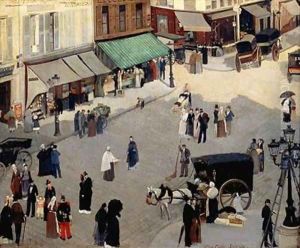Pierre Carriere-Belleuse Paintings
Pierre-Carrière Belleuse, born Pierre Carrier on March 10, 1851, was a French painter known for his portraits, historical and genre scenes, as well as decorative panel paintings. He was the son of the famous sculptor Albert-Ernest Carrier-Belleuse, and often he is referred to with the hyphenated surname to associate him with his father's artistic legacy. Though less well-known than his father, Pierre had a successful career in his own right, exhibiting his works and gaining recognition in the late 19th and early 20th centuries.
Educated in the arts from a young age due to his father's influence and position in the art world, Pierre initially trained under his father's guidance before seeking formal education at the École des Beaux-Arts in Paris. He was a student under Alexandre Cabanel, a French painter who was well-regarded for his history paintings and a prominent figure in the academic art world of the time.
Pierre Carrière-Belleuse's career was marked by his participation in the Paris Salon, the official art exhibition of the Académie des Beaux-Arts in Paris. His works were frequently exhibited there, and he received favorable reviews for his elegant and detailed painting style which often reflected the academic tradition. His genre scenes often depicted moments of daily life imbued with a sense of romanticism and nostalgia, which was quite popular among art patrons of the period.
Unlike the Impressionists and other avant-garde artists of his time, Carrière-Belleuse remained more traditional in his approach to painting. His work did not seek to break with the techniques and subjects that were endorsed by the art establishment. Instead, he focused on perfecting his craft within the boundaries of the styles that were widely accepted and celebrated by the Salon and its audiences.
Pierre Carrière-Belleuse's legacy, while overshadowed by the fame of his father and the more revolutionary artists of his time, remains as a testament to the skilled craftsmanship and the aesthetic values of the Belle Époque. His death on February 29, 1932, marked the end of a career that spanned over five decades, during which he contributed to the rich tapestry of French art history.
